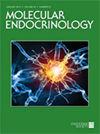CHOP参与IAPP诱导的β-细胞凋亡,但不是唯一的介质。
Q Biochemistry, Genetics and Molecular Biology
引用次数: 37
摘要
2型糖尿病胰岛的特点是β细胞丢失,β细胞凋亡增加,胰岛淀粉样蛋白来源于胰岛淀粉样蛋白多肽(IAPP)。当蛋白质错误折叠保护机制被克服时,人IAPP (h-IAPP)形成膜渗透毒性低聚物,诱导β细胞功能障碍和凋亡。在2型糖尿病患者(T2D)和h-IAPP转基因小鼠中,内质网(ER)应激是由CCAAT/增强子结合蛋白同源蛋白(CHOP)的核易位推断的,后者是一种已知的内质网应激介质。为了确定h-IAPP毒性是否由内质网络应激介导,我们评估了h-IAPP转基因(h-TG)小鼠的糖尿病发病和β细胞质量,并将其与野生型对照进行了比较。h-TG CHOP(-/-)小鼠的糖尿病延迟,β细胞质量相对保留,β细胞凋亡减少。CHOP的缺失减弱了h-TG小鼠β-细胞自噬/溶酶体通路的功能障碍,揭示了CHOP在介导h- iapp诱导的自噬功能障碍中的作用。由于CHOP的缺失延迟但不能阻止h- iapp诱导的β细胞损失和糖尿病,我们研究了CHOP不依赖的应激途径。IRE-1pTRAF2复合物的靶点JNK和ATF4的靶点Bcl-2家族促凋亡介质BIM在CHOP存在和不存在的情况下,h-IAPP的表达激活程度是相同的。因此,虽然这些研究证实CHOP是h- iapp诱导内质网应激的中介,但它并不是唯一的中介。因此,单独抑制CHOP不太可能是一种持久的治疗策略,以防止h-IAPP毒性,因为多种应激途径被激活。本文章由计算机程序翻译,如有差异,请以英文原文为准。
CHOP Contributes to, But Is Not the Only Mediator of, IAPP Induced β-Cell Apoptosis.
The islet in type 2 diabetes is characterized by β-cell loss, increased β-cell apoptosis, and islet amyloid derived from islet amyloid polypeptide (IAPP). When protein misfolding protective mechanisms are overcome, human IAPP (h-IAPP) forms membrane permeant toxic oligomers that induce β-cell dysfunction and apoptosis. In humans with type 2 diabetes (T2D) and mice transgenic for h-IAPP, endoplasmic reticulum (ER) stress has been inferred from nuclear translocation of CCAAT/enhancer-binding protein homologous protein (CHOP), an established mediator of ER stress. To establish whether h-IAPP toxicity is mediated by ER stress, we evaluated diabetes onset and β-cell mass in h-IAPP transgenic (h-TG) mice with and without deletion of CHOP in comparison with wild-type controls. Diabetes was delayed in h-TG CHOP(-/-) mice, with relatively preserved β-cell mass and decreased β-cell apoptosis. Deletion of CHOP attenuates dysfunction of the autophagy/lysosomal pathway in β-cells of h-TG mice, uncovering a role for CHOP in mediating h-IAPP-induced dysfunction of autophagy. As deletion of CHOP delayed but did not prevent h-IAPP-induced β-cell loss and diabetes, we examined CHOP-independent stress pathways. JNK, a target of the IRE-1pTRAF2 complex, and the Bcl-2 family proapoptotic mediator BIM, a target of ATF4, were comparably activated by h-IAPP expression in the presence and absence of CHOP. Therefore, although these studies affirm that CHOP is a mediator of h-IAPP-induced ER stress, it is not the only one. Therefore, suppression of CHOP alone is unlikely to be a durable therapeutic strategy to protect against h-IAPP toxicity because multiple stress pathways are activated.
求助全文
通过发布文献求助,成功后即可免费获取论文全文。
去求助
来源期刊

Molecular endocrinology
医学-内分泌学与代谢
CiteScore
3.49
自引率
0.00%
发文量
0
审稿时长
12 months
期刊介绍:
Molecular Endocrinology provides a forum for papers devoted to describing molecular mechanisms by which hormones and related compounds regulate function. It has quickly achieved a reputation as a high visibility journal with very rapid communication of cutting edge science: the average turnaround time is 28 days from manuscript receipt to first decision, and accepted manuscripts are published online within a week through Rapid Electronic Publication. In the 2008 Journal Citation Report, Molecular Endocrinology is ranked 16th out of 93 journals in the Endocrinology and Metabolism category, with an Impact Factor of 5.389.
 求助内容:
求助内容: 应助结果提醒方式:
应助结果提醒方式:


